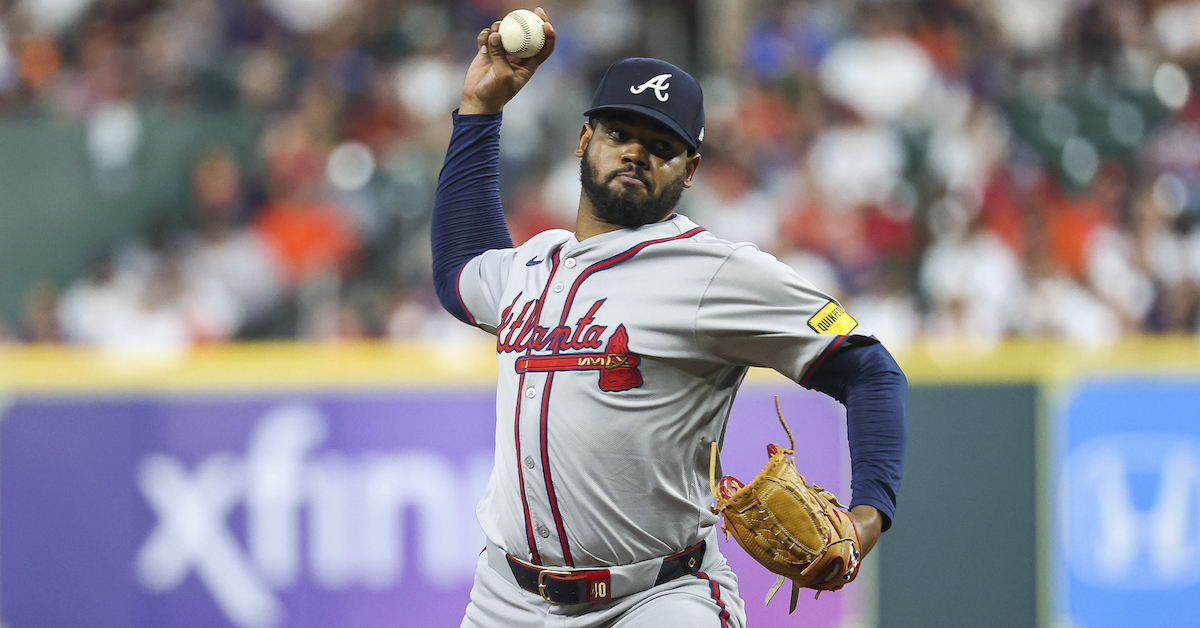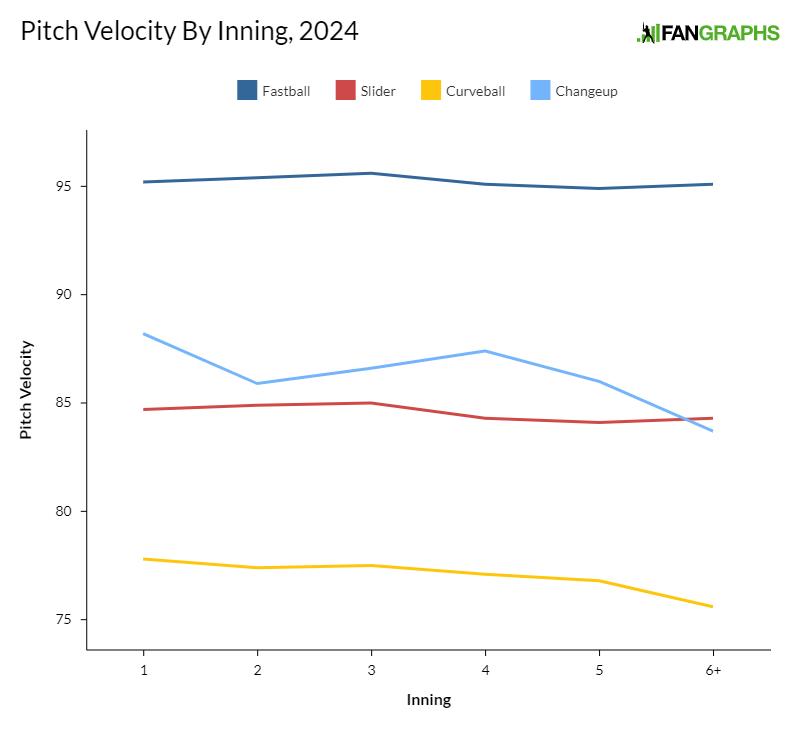
Troy Taormina-USA TODAY Sports
When the Braves signed Reynaldo López to a three-year, $30 million contract last winter, I was confused. Like most people in baseball, I thought López and Lucas Giolito had an E.T.-and-Elliott thing going on, where they couldn’t be separated. They’d come up together as minor leaguers with the Nationals, before being traded together to the White Sox, then traded again to the Angels, then waivered over to Cleveland, all without breaking the telepathic link.
Denuded of his longtime colleague, López cut a curious figure. The White Sox had tried to make him a starter in the late 2010s and it went badly. The only time López has ever led the league in anything was when he led the league in earned runs allowed in 2019. Since the dawn of the 2020s, he’s been a reliever, and a good one, but it was unlikely he’d return to the rotation, let alone for a team with standards as high as Atlanta’s.
But starting pitching is harder to come by than ever these days, and a major theme of the 2023-24 free agent class was, “OK, but let’s make absolutely sure this guy can’t start.” Jordan Hicks, Jakob Junis, Nick Martinez, Michael Lorenzen, and López, of course.
So far, so good. López has been Atlanta’s best starter this year, with an ERA of 1.53 in six starts. He completed six innings in the first four of those appearances, and in five of his six starts he’s allowed a maximum of one earned run. The one outlier involved just three runs over five innings and seven strikeouts; hardly a stinker.
How is he doing it?
Well my first question when considering a reliever making a move to the rotation is how his velocity’s holding up as the game goes on — especially considering that López has actually been pitching quite deep into games by modern standards. The answer: Great, thanks for asking.

That does look like a precipitous decline in changeup velocity toward the end, but not to worry: López has only thrown one changeup this year in the sixth inning or later. In fact, López has greatly decreased his use of the changeup. Since 2021, López has been almost exclusively fastball-slider against same-handed hitters, and that has changed not one iota since he’s moved to the rotation. But he’s worked his curveball, which was little more than a show-me pitch last season, into heavy rotation against lefties.
And thank goodness. López is not faring that well generally against lefties; his .317 opponent wOBA is his highest mark since the last time he was in the rotation, and he’s walking 15.6% of the left-handed hitters he’s faced. But that’s not his curveball’s fault.
López has thrown 14 changeups this year, all to lefties. Four of them have been put in play, and of those, two have gone over the fence — the only two home runs he’s has allowed in six starts. His curveball, by contrast, has been a weapon.
López’s Breaking Balls vs. LHB
| Year |
Pitch % |
BA |
OBP |
SLG |
Whiff% |
| 2021 |
31.1 |
.206 |
.270 |
.441 |
22.7 |
| 2022 |
32.7 |
.216 |
.211 |
.459 |
31.7 |
| 2023 |
22.8 |
.237 |
.293 |
.395 |
41.5 |
| 2024 |
32.9 |
.120 |
.185 |
.200 |
43.9 |
SOURCE: Baseball Savant
That table obviously ropes in López’s slider, which he throws to both left- and right-handed batters. That pitch has been just as effective, if not more so. Opponents are hitting .130 and slugging .152 against the slider, with a whiff rate of 46.2%. Chris Sale and Dylan Cease are no. 1 and 2 in Baseball Savant’s slider run value leaderboard, but López is getting more swings and misses than either of them.
Last year, López’s slider was mediocre, and while its spin rate is largely unchanged, it has a slightly different movement profile this year. In 2023, it was very horizontal, but now, it’s got a little vertical drop to it. That’s assisted by something you might not think of as a positive: López isn’t throwing as hard this year as he did last year.
That’s to be expected. Just as a 100-meter sprinter runs faster than a miler or a marathoner, a one-inning reliever throwing maybe 20 pitches a night is going to throw harder than a starter who, like López, is living in the 80-to-95-pitch range. Some velocity loss is just the price of doing business.
And indeed, López’s pitches might be consistent inning to inning this year, but they’re down about two or three miles per hour across the board from where they were last year. It could be worse; Hicks has lost closer to five miles per hour in velocity, even though his transition to the rotation has been largely successful thus far.
But that explains the difference in movement on López’s slider. Because it’s moving more slowly, it’s staying in the air longer, which gives gravity more time to act, and it’s dropping more. The same is true for the curveball, which now lives in the 77 mph range, down from about 80 the past two seasons. And it’s not like López lacks gas. His 95.2 mph average fastball velocity is still in the top quartile of qualified starters, and he can still reach back for 97 and 98 when he needs it.
As encouraging as these new developments are, López doesn’t actually need to get better to be a success in the Braves’ rotation. There’s reason to expect him to cool off fairly soon — apart from the fact that a 1.53 ERA is facially ridiculous. López has the eighth-worst walk rate among 79 qualified starters, and the eighth-biggest gap between his ERA and FIP.
But let’s say that he pitches, on a rate basis, as well as he did last season. In 68 appearances totaling 66 innings in 2023, López had an ERA of 3.27 and a FIP of 3.91. How valuable is that? It’s nice, but nobody’s going to write about it. López posted 0.8 WAR and was a throw-in in a desperation trade at the deadline.
But what if he could put up that ERA and FIP over a full season? López made 32 starts and threw 188 2/3 innings in 2018 and made 33 starts for 184 innings in 2019. Don’t look at his… hey — HEY! — I said don’t look at his other stats in those seasons. I’m just pointing out that there’s a historical precedent for him holding up for a full year in the rotation.
If he does, and repeats his 2023 rate stats, how valuable would that be? Well, last season, eight qualified starters had an ERA between 3.00 and 3.50 and a FIP between 3.50 and 4.00: Framber Valdez, Jordan Montgomery, Luis Castillo, Corbin Burnes, Merrill Kelly, Justin Verlander, Charlie Morton, and José Berríos.
Those aren’t fifth starters, they’re All-Stars. And they don’t make $10 million a year in free agency, they make two or three times that much. The Braves don’t need anything more from López than what he’s already doing. They just need about 25 more starts’ worth of it.
Source
https://blogs.fangraphs.com/lets-check-in-on-reynaldo-lopez/
 Backyard GrillingWeekend WarriorsAdvice from DadBeard GroomingTV Shows for Guys4x4 Off-Road CarsMens FashionSports NewsAncient Archeology World NewsPrivacy PolicyTerms And Conditions
Backyard GrillingWeekend WarriorsAdvice from DadBeard GroomingTV Shows for Guys4x4 Off-Road CarsMens FashionSports NewsAncient Archeology World NewsPrivacy PolicyTerms And Conditions
